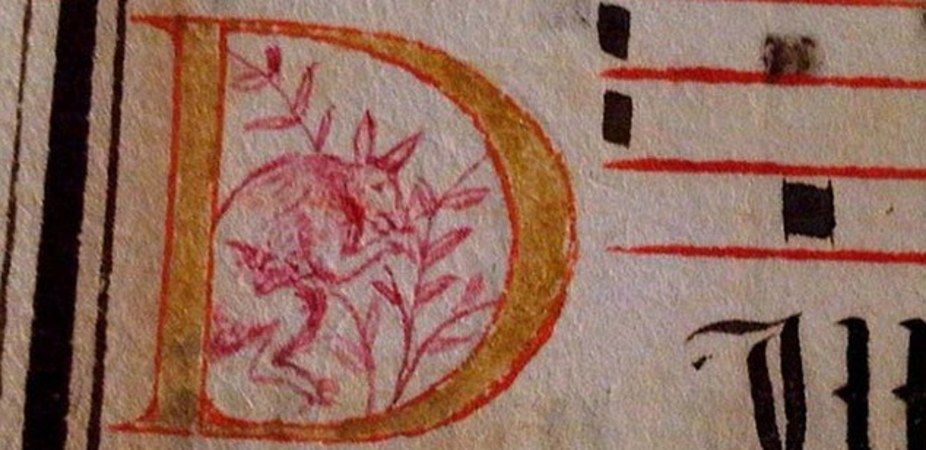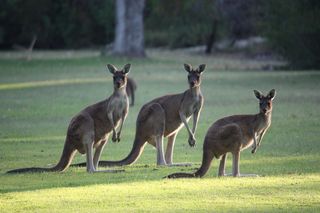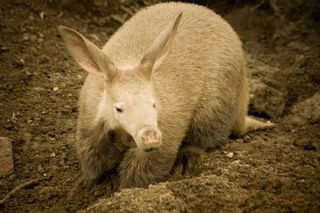
That's No Kangaroo on the Manuscript – So What Is It? (Op-Ed)

This article was originally published at The Conversation. The publication contributed the article to LiveScience's Expert Voices: Op-Ed & Insights.
The discovery of a Portuguese manuscript purporting to include an illustration of a kangaroo has been used to question which European power was first to “discover” Australia.
The drawing is included in a pocket-sized religious manuscript, dated at between 1580 and 1620, and has widely been described as a kangaroo in various media reports.
The Les Enluminures gallery that holds the manuscript, currently for sale, first fuelled the Australian debate with its description of the illustration:
Of particular interest are the images reflecting Portuguese exploration, including a kangaroo or wallaby, and two small male figures, possibly natives of Australia or elsewhere in Southeast Asia.

The first Europeans to Australia
Exactly which European nation was the first to discover Australia is still unclear. While it is well established that the Dutch mariner Willem Janszoon and his crew on the Duyfken contacted Cape York in 1606, it is also possible that Portuguese mariners might have preceded the Dutch.
Given the extent of their remarkable maritime empire in the 15th to 17th centuries, and the advanced state of Portuguese navigation at that time, contact with the Australian landmass would seem plausible.
Several lines of evidence have been advanced for a Portuguese discovery of Australia. These include the so-called Dieppe maps, and purported Portuguese relics from several sites on the Australian coast.
Sign up for the Live Science daily newsletter now
Get the world’s most fascinating discoveries delivered straight to your inbox.
Most of these are disputed, so that the case for an early Portuguese contact with Australia appears to a non-historian, such as me, problematic.
Another possible candidate
However, several alternative identifications of this manuscript animal are possible, and in many respects the it resembles an aardvark much more than any kangaroo.

The relevant features include the animal’s elongated and terminally-flattened snout, its long narrow ears, its robust thorax, and the proportions its limbs.
While kangaroos possess a relatively elongated snout, this is substantially more elongated in aardvarks, and seemingly the manuscript animal. A flat-ended snout is not found in any kangaroos or wallabies, but is characteristic of aardvarks, and indicated in the drawing.
The ears of aardvarks, like those in the drawing, are relatively much longer and narrower than those of kangaroos.
No less significant are the thorax and the limbs. Aardvarks are powerful diggers and this is reflected in their deep thorax and stout upper arms. Similar features are indicated in the drawn animal, and distinguish both animals from kangaroos which have shallow chests and relatively slight upper arms.
The relative proportions of forelimbs and hindlimbs of the manuscript animal are consistent with it being an aardvark. As indeed is its posture, since aardvarks like other strong digging mammals often use a bipedal stance and balance on their hindlimbs alone.
The manuscript drawing seems to have been based on a live, rather than a tanned specimen. Features that suggest this are the life-like disposition of its head and especially its ears, and its stance. This argues for an animal native to an area close to Portugal, rather than one as distant as Australia.
Where to find an aardvark
The aardvark is broadly distributed across sub-Saharan Africa, and distribution maps indicate a range that extends close to the west coast of that continent. This is relevant for this coast is where the Portuguese established a series of trading posts in the 15th century.
That a live aardvark might have been accessible to the manuscript artist might seem unlikely. However, Portuguese kings are known to have maintained menageries for centuries before the manuscript date.
Vernon Kisling’s Zoo and Aquarium History tells how King Dom Manuel I (reign 1495-1521) maintained at his royal palace menagerie in Ribiera (Lisbon) antelope, lions and a trained cheetah, and at a second royal menagerie in Estậos, a herd of elephants and other large animals.
Based on these considerations, I believe that the identification of the manuscript animal as a kangaroo is highly questionable, and certainly not supportive of the suggestion that the Portuguese contacted Australia before the Dutch.
Other, more substantial, lines of evidence are needed to make that case.
Peter Pridmore does not work for, consult to, own shares in or receive funding from any company or organisation that would benefit from this article, and has no relevant affiliations.
This article was originally published at The Conversation. Read the original article. The views expressed are those of the author and do not necessarily reflect the views of the publisher. This version of the article was originally published on LiveScience.












